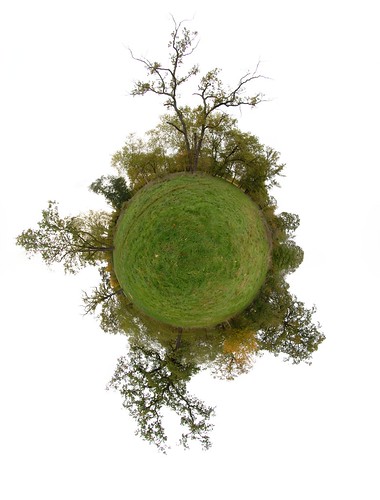 Seb Przd is blowing my mind! He's doing a lot with panoramas, HDR, and reprojection-- lovely collections.
Seb Przd is blowing my mind! He's doing a lot with panoramas, HDR, and reprojection-- lovely collections.
Saturday, December 22, 2007
Wednesday, December 19, 2007
 The blue LED's are invading my life. I hate them.
The blue LED's are invading my life. I hate them.
It would be difficult to replace blue LED's with "regular" (read: red, green, yellow, or white) ones-- for surface-mount LED's and RGB ones, I'd more likely damage the circuit board... though outright removing one would be almost as good as replacing one, with the added spiteful element of having gouged its eye out for irritating mine...
Blue LED's are alienating to many people, especially those over a certain age; they seem alien and "wrong" somehow, and it's not a result of growing up with LED's of colors other than blue, but the fact that we simply do not see blue glowing things in nature. Red, yellow, orange and white are colors we know from fire and the stars-- light sources in nature-- and these have been the colors of electronic light elements until a few years ago.
We should have learned in chemistry lab to fear blue flames since they're so hard to see, and blue-lit electronics are successors to customized cars' blue neon undercarriage lighting. These are menacing associations for me, and they also evoke cheapness and cheesy after-market design.
The blue LED has invaded consumer-level electronics and is starting to make it into higher-end electronics as well, and I think it will have an overall cheapening effect on the brand images of those companies who choose to use them. It's a high-tech artifact motif like the raw polygon and aliased pixel, and I hope it will go away after we get over its novelty.
Sunday, December 09, 2007
Wednesday, December 05, 2007
 Just heard about this "little planets" method for inverting panoramas into a stereographic projection, which is not what I'd expect it to be called. Of course there's a stereographic projection Flickr group-- very cool to browse.
Just heard about this "little planets" method for inverting panoramas into a stereographic projection, which is not what I'd expect it to be called. Of course there's a stereographic projection Flickr group-- very cool to browse.Seems like all you need to do is:
- Shoot and stitch a complete spherical panorama to get an image with an aspect ratio of 2,
- Rotate the image 180 degrees,
- Stretch the image so it's square (aspect ratio 1),
- Run Filters > Distort > Polar Coordinates..., with the "Rectangular to Polar" option.
Friday, November 30, 2007
Friday, November 02, 2007
 old American Cinematographer article on Stanley Kubrick's use of a special 50mm f/0.7 lens used on Barry Lyndon.
old American Cinematographer article on Stanley Kubrick's use of a special 50mm f/0.7 lens used on Barry Lyndon.
Wednesday, August 15, 2007
 Found a good page at Cornell on the ISO 12233 Test Chart, along with links to two companies-- Sine Patterns and Precision Optical Instruments-- who sell test patterns in different sizes and formats.
Found a good page at Cornell on the ISO 12233 Test Chart, along with links to two companies-- Sine Patterns and Precision Optical Instruments-- who sell test patterns in different sizes and formats.
Friday, June 08, 2007
 Thinking of places to stop on my trip re: art, architectural, and photographic history.
Louis Daguerre was French... where was that window where he took that picture? No, it was Joseph-Nicephore Niepce, out his studio window.
Thinking of places to stop on my trip re: art, architectural, and photographic history.
Louis Daguerre was French... where was that window where he took that picture? No, it was Joseph-Nicephore Niepce, out his studio window.The Wikipedia Photography Timeline is pretty cool.
Google Street View has nice display and interaction of registered panoramic images. They were taken by Immersive Media and by Google using their own custom camera rig. You can tell which by figuring out the camera heght-- the van's pov is much higher. Interesting Boing Boing coverage covers a few issues, but the big qustion for everybody is:
Is this creepy or not, and why?
Monday, February 12, 2007

| >>> |

|
Tuesday, January 23, 2007
Monday, January 08, 2007
 Scientists at the U.S. DOE Ames Laboratory have developed a silver-based, mesh-like material with a negative index of refraction:
Scientists at the U.S. DOE Ames Laboratory have developed a silver-based, mesh-like material with a negative index of refraction:
Metamaterials, also known as left-handed materials, are exotic, artificially created materials that provide optical properties not found in natural materials. Natural materials refract light, or electromagnetic radiation, to the right of the incident beam at different angles and speeds. However, metamaterials make it possible to refract light to the left, or at a negative angle. This backward-bending characteristic provides scientists the ability to control light similar to the way they use semiconductors to control electricity, which opens a wide range of potential applications.
Subscribe to:
Posts (Atom)

 Homemade cheapo bellows
Homemade cheapo bellows Blueprint paper photography
Blueprint paper photography Etienne-Jules Marey (1830-1904), Photographer of Fluids
Etienne-Jules Marey (1830-1904), Photographer of Fluids

